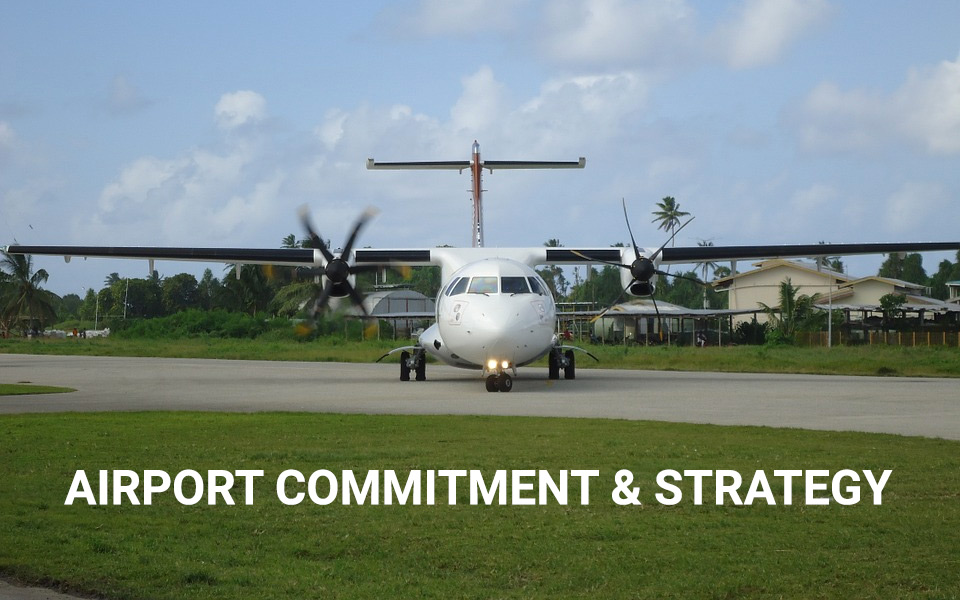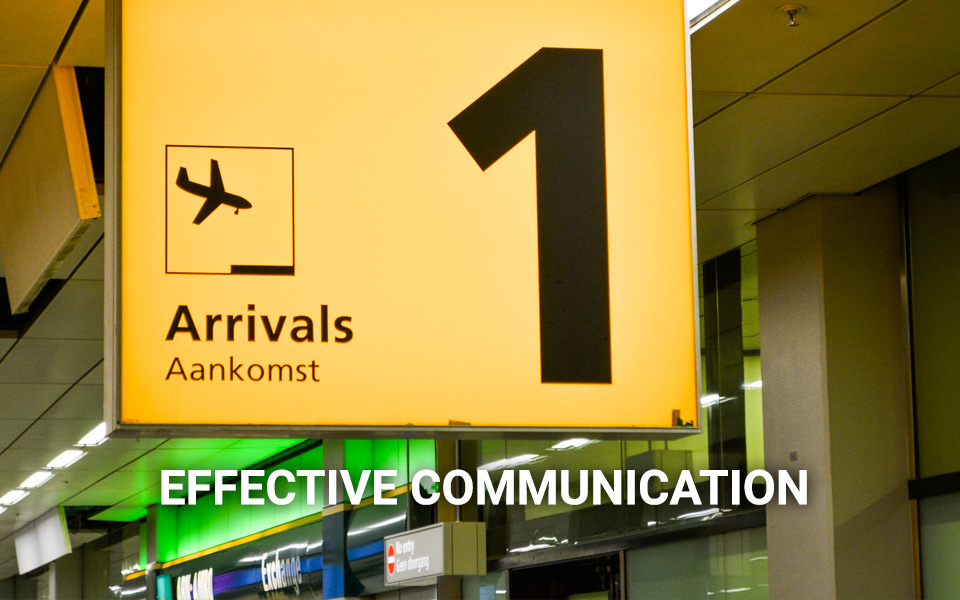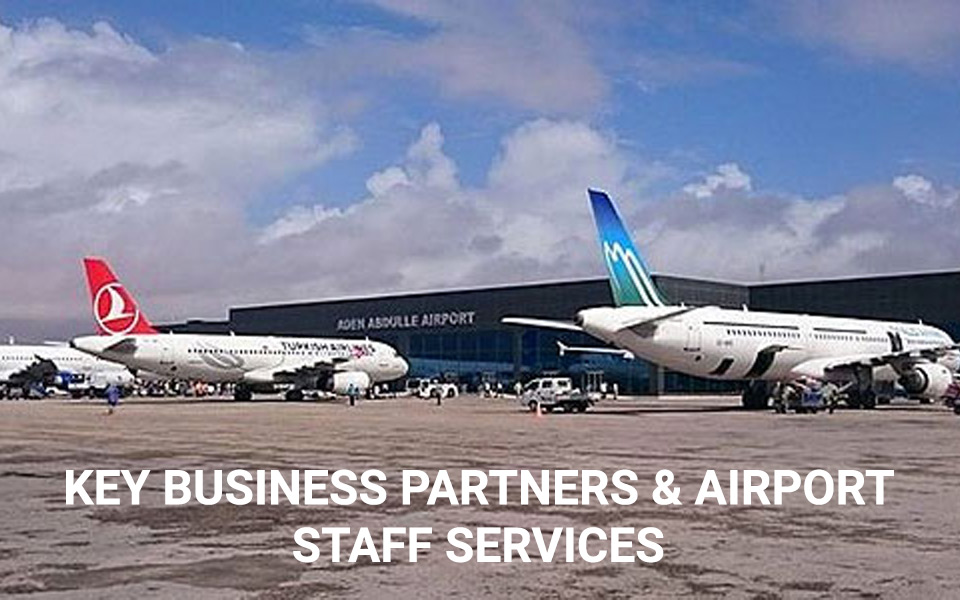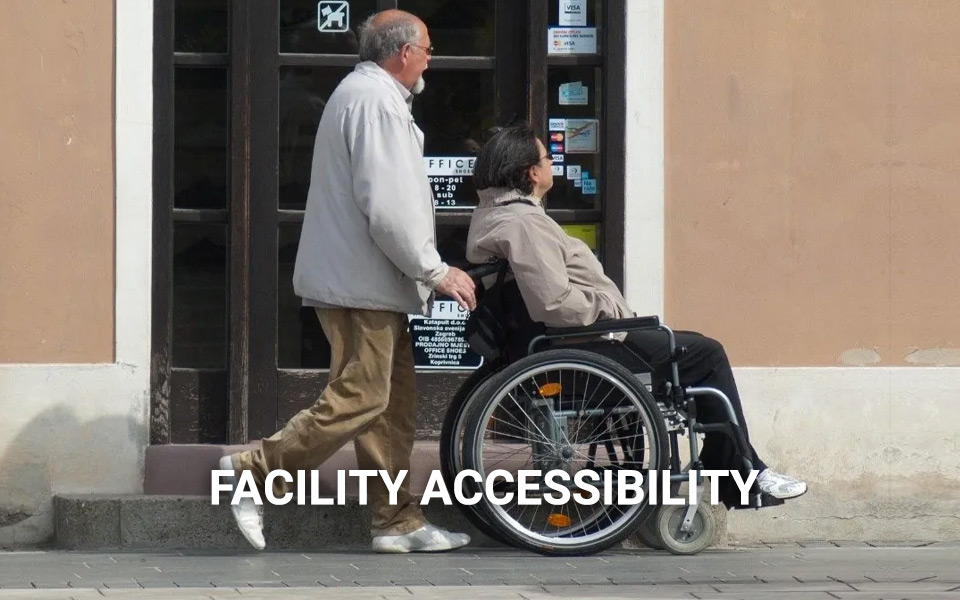A Companion WebResource to ACRP Research Report 239:
Assessing Airport Programs for Travelers with Disabilities and Older Adults
Effective Communication
Preparing for a trip can be a stressful experience. This is especially true for travelers with disabilities and older adults, who often experience anxiety before travel because so many pieces have to come together to create a seamless airport journey. These travelers may also fly less frequently and therefore be less aware of the facilities and services available to them. Communication from the airport, therefore, is extremely important in planning accessible transportation to and from the airport as well as determining how their specific needs can be met on arrival from ground transportation and in the terminal.
To ensure that the air travel experience for individuals with disabilities and older adults is indeed seamless, airports need to communicate and coordinate efforts across departments, while also working closely with all the other stakeholders who interact with and serve these customers.
The following notable practices enhance communication with the airport’s key stakeholders and improve navigation of the airport.
1. Digital Accessibility
1.1 Web accessibility
- To ensure that all user needs are addressed, use current Web Content Accessibility Guidelines (WCAG) standards for web accessibility on mobile devices, as well as desktop and laptop computers.
- In addition to using automated accessibility website checkers, conduct tests using individuals with a variety of physical, sensory and cognitive disabilities. A good source for hiring reputable specialists in website development and testing is the International Association of Accessibility Professionals.
- Provide training on the basics of web accessibility to anyone developing website content at the airport, and assign someone with more advanced knowledge to check content for accessibility before posting. This will help maintain the website’s accessibility over time.
- Provide a Website Accessibility Statement at the bottom of the home page with a link to report any problems.
- Include an end use survey to ensure that the website is meeting the needs of all travelers.
1.2 Mobile application accessibility
- To ensure that all user needs are addressed, meet current WCAG standards as applicable.
- Follow guidelines on app development in ACRP Research Report 177: Enhancing Airport Wayfinding for Aging Travelers and Persons with Disabilities.
- Design applications to work on both Android and iOS devices.
- Work with developers who specialize in accessibility.
2. Pre-trip Communication and Information
In addition to the standard website content that benefits all members of the traveling public, individuals with disabilities need to be assured that their specific needs can be met while traveling to, from and at the various airports they use during their journey. The more detailed and specific the information, the better. Making it easy to find disability-related content is also critical, as more effort is required by many of these individuals to navigate the website.
The following are specific types of information beneficial to all travelers with disabilities that a growing number of airports now include online:
- Hours of operation;
- Links to accessible transportation providers and details on accessible shuttles at the airport;
- Links to TSA disability-related information and videos, as well as contact information for TSA Cares;
- Links to airline accessibility pages and phone numbers;
- Links to federal regulations, including the Americans with Disabilities Act (ADA) and the Air Carrier Access Act;
- Exact locations of disability-related amenities (companion care restrooms, adult changing spaces, sensory rooms, service animal relief areas, etc.) and other services and concessions (e.g., by listing the nearest gate, as in the case of Dallas–Fort Worth International Airport);
- Walk times or distances from curbs to check-in or from security to gates;
- Contact information for service providers at the airport and, if more than one, the airline they work for; and
- How to get assistance on arrival from ground transportation (e.g., curbside, parking or other drop-off point).
Other notable practices to improve access to information are as follows:
- Locate disability-related information on a single webpage, one click away from the home webpage. Posting an international symbol of accessibility pictogram with a link to the “Accessibility” page on the webpage header, like Los Angeles International Airport (LAX) and Hartfield-Jackson Atlanta International Airport, puts this important topic a click away from every other webpage.
- Organize accessibility content by disability type to enable users to zero in on the topics important to them.
- Use plain language to accommodate customers with cognitive disabilities and limited English proficiency. For basic tips, see “Five Steps to Plain Language” (Center for Plain Language).
- Provide a foreign language option on the website for non-English speakers to select an alternative language.
- For travelers with hearing loss, include information on how to communicate by text or email as well as teletypewriter and video relay. In addition to captioning any videos and virtual tours, the website should provide details on any assistive technologies at the airport (hearing loops, video remote interpreting, public video phones, visual paging, text telephones, etc.).
- For travelers with vision loss, include a text map describing the airport’s overall layout, location of airline check-in counters, security checkpoints, concourses, etc. to help orient these individuals before the day of travel.
- For travelers with cognitive or developmental disabilities, provide social stories or apps to prepare them for the airport experience as well as for use at the airport. Also, promote familiarization programs as well as lanyard programs for self-identification by individuals with hidden disabilities.
- To encourage feedback, provide a Website Accessibility Statement at the bottom of the home page, with a link to report any problems. Including an end use survey will also help to determine if the website is meeting the needs of all travelers.
- Provide pre-book services such as parking, including accessible parking spaces as well as valet parking.
3. Onsite Customer Communication and Information
Notable practices to improve onsite customer communication include the following:
- Provide information on social media, the airport website, airport app and signage at information counters throughout the airport on a specific assistance number, available 24/7.
- Assign a specific person/division to respond to the contact number, including after-hours, such as airport security personnel.
- Communicate travelers’ requests for assistance from the source to other appropriate parties, such as the airport, airline and/or third-party providers.
- Develop and implement a CX/CS/Accessibility Communications Plan that includes all channels, especially social media, and all customers.
- Review uniforms of airport customer experience employees and volunteers to ensure they are easily identifiable by airport travelers.
- Provide airport staff and volunteers with a standard, easily identifiable uniform, button or vest for travelers to recognize that they are available to assist.
- Communicate the uniform, button or vest on the airport website and airport app, in public relations releases, and at stakeholder meetings to elevate awareness of how to identify airport staff and volunteers.
- Offer airport familiarization tours to provide travelers with an opportunity to practice aspects of the airport journey in preparation for upcoming travel.
- To ensure signage meets standards of accessibility in terms of contrast, glare, positioning, font size, refresh rate, etc., airports can refer to the ICC A117.1-2017 Standard for Accessible and Usable Buildings, Section 703.7, New standards for variable message signs (VMS).
- Flight information display screens (FIDS) are the key source of information for travelers awaiting their flights. As space allows, multiple banks of FIDS should be placed throughout the check-in area and concourses, and at a height that allows for close approach. Placing FIDS at eye level and ensuring high contrast between text and background colors will better accommodate travelers with low vision and will make it easier for people of short stature and those seated in wheelchairs to see the screens.
4. Independent Navigation
The ability to navigate independently from an arrival point to the gate is a common preference among travelers of all types. However, because of the complexity of the airport environment, travelers with disabilities and older adults are faced with navigational challenges that basic wayfinding approaches don’t always address. Travelers concerned about navigating the airport may end up requesting wheelchair assistance simply to avoid the stress of finding their way on their own. The following notable practices improve airport wayfinding and navigation.
4.1 Signage systems can be enhanced to improve navigation for travelers with disabilities and older adults
ACRP Research Report 177 states that until facilities are designed to be fully intuitive, signage will always be the most important aspect of wayfinding. However, if accessibility is not considered in the design process, this useful resource can quickly become an obstacle. Common pain points include when signage is cluttered and when low-contrast colors and uncommon symbols are used.
Basic best practices in signage design include, but are not limited to, using color combinations that achieve high contrast (light on dark or dark on light), using large font size with wider letter spacing, and using both words and common symbols. ACRP Research Report 177 identified several factors that should be considered when designing signage.
In addition to design, it is important to be purposeful in the placement of signage. Poor placement can unintentionally hide signage behind other signs and architectural features, such as the ceiling on vertical transitions. Travelers who use wheelchairs and those of short stature are more commonly affected by poor placement because of obstructed sight lines when looking from a lower angle. This is another opportunity for airports to include people with disabilities in accessibility assessments. By including people who use mobility devices in the initial placement of signage as well as in periodic accessibility checks, signage can remain equally reliable for travelers with and without disabilities.
4.2 Location of all accessible or disability-related amenities is indicated
- Indicate the locations of all disability-related amenities and indicate airport layout, airport app and airport directories located strategically throughout the terminal on the website.
- For individuals with vision loss who cannot access standard maps, list the nearest gate for all services and amenities post-security, and provide a text map to orient the individual to the different areas of the airport: arrival points, check-in lobby, security and concourses.
- Review restroom signage and locations for accessible restrooms to ensure convenient accessible restrooms, including companion restrooms, pre-security and throughout each concourse.
- Provide tactile directories with pictograms at elevator banks and in elevator cars. Although this is not required under the Americans with Disabilities Act Accessibility Guidelines, this universal design solution benefits those with vision loss, cognitive disabilities and limited English proficiency.
- Provide tactile maps outside of service animal relief areas.
- Provide text maps on the website.
4.3 Visual information provided through terminal design
- Review existing signage to ensure there are no gaps, misdirection or missing information causing travelers to lose their way.
- Review existing signage to ensure signage is clearly viewable by people of short stature, those seated in a wheelchair or those with limited vision.
- Review wayfinding signage to ensure that the font and colors are readable by all passengers, including people with low vision, with signage indicating direction to gate and individual gate locations.
- Include both words and pictograms for travelers with cognitive disabilities and foreign travelers.
- Provide floor graphics to guide travelers, particularly wheelchair users, where appropriate. Airports that effectively use floor graphics include Seattle and Vancouver, the latter to direct customers with allergies along their fragrance-free route.
- Employ roving ambassadors to help with navigation.
- Develop your own airport wayfinding accessibility audit, or use examples from other sources.
- Use services such as Travelers Aid, and recruit airport volunteers.
4.4 Wayfinding technologies
- Provide verbal turn-by-turn wayfinding assistance in the airport app.
- Provide free third-party services for traveler use, such as airport-provided Aira minutes.
- Promote the availability of the app and download instructions on the website and social media.
- Ensure the mobile app is accessible using current WCAG standards.
5. Communication with the Airport Public and Customers with Disabilities and Older Adults
Communication needs among travelers with disabilities and older adults vary depending on the type of disability. Therefore, it is important to develop a focused communication strategy targeting this group of travelers to ensure everyone is getting the content they need in the medium or format most accessible to them, both pre-trip and at the airport.
A growing number of both travelers with disabilities and older adults do use digital technologies and mobile devices, but print media and face-to-face interaction remain important for these customers, as do call centers. Wherever possible, providing information both verbally and visually, throughout the airport terminal and on airport shuttles and people movers, is effective in reaching most travelers. On shuttles at Orlando International Airport, for example, information on baggage claim is provided verbally and via an LED readout.
6. Emergency Planning and Irregular Operations (IROPS)
Notable practices to meet the varying communication limitations among people with disabilities, particularly those with vision loss, hearing loss and cognitive disabilities, include:
- Include specific instructions in the airport emergency plan, in discussions with command center staff and/or planners preparing for emergency response, for providing accommodations during irregular operations (IROPS) and emergencies for the various travelers with disabilities and/or older adults.
- Invite community organizations representing segments of the various travelers with disabilities and older adults to participate in providing suggestions when planning tabletop or disaster planning exercises.
- Review relevant guides and literature, including Evacuation of People with Disability & Emergent Limitations: Considerations for Safer Buildings & Efficient Evacuations, ACRP Research Report 170, ACRP Research Report 210 and ACRP Synthesis 56, to identify some of the short-term solutions that can be implemented immediately.
- Review FAA guidance: “Best Practices for Enhancing Traveler Experience: Addressing the Needs of Persons with Disabilities and Individuals with Limited English Proficiency in Airport Emergency Evacuation Plans.”
- Review the Federal Emergency Management Agency guide “Guidance on Planning for Integration of Functional Needs Support Services in General Population Shelters.”
- Develop emergency response and IROPS plans in collaboration with stakeholders. The San Jose International Airport (SJC) “Emergency Evacuation Policy,” which has sections on passengers with disabilities and functional limitations, is available on their website.
- Include people with disabilities in emergency exercises. ACRP Synthesis 90 lists a number of airports, including Minneapolis–Saint Paul International Airport and LAX, that include individuals with a variety of disabilities in their exercises.
- Include an ADA coordinator in the emergency command center.
- Include supplies for older adults, people with disabilities, service animals, etc. in emergency preparedness kits (e.g., adult diapers, catheters, sanitary pads, dog food).
- Review the airport emergency plan to discover specific planning elements that address the various traveler segments with disabilities and to accommodate their needs in times of crisis.
- Provide specific information on emergency plans on the website and terminal signage.
- Provide disability awareness training for airport stakeholders on how to enhance their assigned responsibilities for people with disabilities and older adults.
- Provide communication/disability awareness training for first responders.
- Stage evacuation chairs at stairways for use when elevators are out of service. Airports with evacuation chairs include SJC and Philadelphia International Airport.
- Ensure the emergency communication system meets the accessibility needs of all travelers—for example, via visual fire alarms, verbal announcements, visual messaging on FIDS and gate information displays, or SMS messaging.
MINI CASE STUDY: TORONTO PEARSON INTERNATIONAL AIRPORT
EFFECTIVE COMMUNICATION
Example of effective communication and navigation
Digital accessibility and communication
Region: Canada
Toronto Pearson (YYZ) excels at communication for persons with disabilities, both pre-trip and at the airport. The website lists a phone number staffed 24 hours a day that travelers may call when arriving curbside or at the parking garage. Live chat is available for those who prefer to text any questions or requests pre-trip or while onsite. The website includes a Web Accessibility Statement and provides details on the airport’s numerous amenities and services.
A new accessible help point with braille and tactile signage that enables customers to request assistance curbside is featured on the homepage.
Travelers can request assistance using accessible help phones near the designated drop-off area for travelers with disabilities (parking garage, light rail station). The phones connect to a central information counter where airport personnel will ask for a description of the traveler and the airline they’re flying with, then the traveler is connected to an airline representative who dispatches an agent to assist the traveler at their location. Once in the terminal, YYZ staffs over 350 volunteers in addition to paid staff that provide customer service and passenger assistance at the airport.
Collaboration and communication with key stakeholders
YYZ, rather than having a disability advisory committee, works with individual groups based on the gaps that it has identified in its programs, services and facilities. The airport collaborates with the airlines through a number of different committees, including the Airport and Airline Operators Committee, to address any operational requirement or concern. An earlier committee helped to design the assistance services program and set basic service levels (key performance indicators). The airport holds bilateral conversations with individual carriers and meets monthly with a small subset of airlines to review how well the core services are functioning, specifically the electric cart service and wheelchair loan service subcontracted by the airport.
Assessment tools
To measure customer satisfaction, YYZ posts an “Accessibility Feedback Survey,” which asks travelers to evaluate the following:
- Wheelchair assistance
- Blindsquare
- Pet relief area
- In-terminal shuttle
- Magnus
- Self-service kiosk
- Sunflower lanyard
- Aira
- Accessible toilets
Customers with disabilities can also provide feedback through intercept interviews, QR codes, when signing onto airport WiFi and via social media.
This toolbar provides a key for the assessment tool icons. Click on each icon for more details



